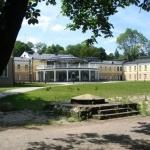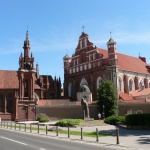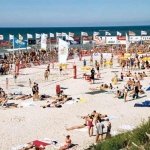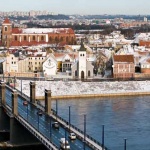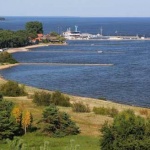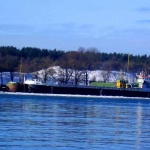Lithuania Sights
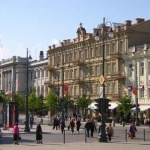 A special expression of local nature, its tranquil beauty and a certain ease and simplicity, the country attracted thousands of fans of quiet rest, and its seaside resorts, dunes, glacial lakes, and respect for nature, provide the country a reputation as one of the best in Eastern Europe, parts of "green" tourism. And, of course, the main attraction of the country - its historical city with beautiful architecture.
A special expression of local nature, its tranquil beauty and a certain ease and simplicity, the country attracted thousands of fans of quiet rest, and its seaside resorts, dunes, glacial lakes, and respect for nature, provide the country a reputation as one of the best in Eastern Europe, parts of "green" tourism. And, of course, the main attraction of the country - its historical city with beautiful architecture.Vilnius
Vilnius (formerly Vilna, Wilno) - the largest city of Lithuania and its capital (the first time in this role is mentioned in 1323). Ancient Vilnius developed in the valley of the river Neris near Upper Castle on the hill and the Lower Castle (not preserved) at its foot, among which "grew" old city with intricate fan-shaped network of streets. Today, Vilnius Old Town - one of the largest in Europe (360 ha) and the main attractions of the country (since 1994 listed as a World Cultural Heritage by UNESCO).
Called the Baroque city of Vilnius, as well as an abundance of architectural monuments of this period is simply colossal. The main sights of the capital are the remnants of the Upper Castle (Castle of Gediminas, XIV-XV cc.), The Old Arsenal (XVI cent.) And the area of Gediminas (Gediminas, the beginning of the nineteenth century.) With the statue of city founder - Grand Duke Gediminas (1316-1341 gg. ) at the foot of Castle Hill, the symbol of the city - the tower of Gediminas, with a survey platform, new arsenal (XVIII cent.), Cathedral Square, the remnants of the XVI century the city walls and gates of Dawn (Medininkskie gate) Artillery Bastion (1640), the ensemble was founded in 1579 University (XVI-XIX cc.), bell tower of the church of St. John, member of the university complex (the highest tower of the Old City - 68 m), Town Hall (1786-1799 gg.) Bishop's Palace (1825-1832 gg .) Verkiai Palace and the Cathedral at the foot of Gediminas (1251, rebuilt several times) to the graves of the Great Duke of Lithuania and relics of the patron saint of Lithuania - St. Casimir, the 52-meter tower at the Cathedral (formerly the watchtower of the Lower Castle, XIII-XVII cc.) Hill of Three Crosses, the Presidential Palace (in the past - the first stone structure after the second baptism of Lithuania in 1387 and the first residence of the bishops of Vilnius), via Pilies (Castle) Castle Raudondvaris etc.
And, of course, churches and churches - a real calling card of Vilnius. In no other city in Eastern Europe at such a small area there is no such accumulations of magnificent temples. The most interesting Gothic church Mikaloyanus (Church of St. Mihaila, XIV cent.), The church and the Bernardine Monastery (XVI century., Its Gothic church is one of the largest in Lithuania), the Church of St. Anne (XV-XVI cent.), The church Mikola (St. Mykolas, XVI-XVII vv.) Church of the Holy Spirit (the only baroque Orthodox Church in Lithuania, 1624-1638 gg.) Church of St. Peter and Paul Church, the Theotokos Cathedral (one of the oldest Orthodox churches in Lithuania, XIV -XIX cc.) Friday Church (the first Christian chapel stone structure of the capital, in 1345), Church of St.George (1506), Church of St. Bartholomew (1824), the ensemble of the church of St. Ignotasa (XVII century. ), Church of St. Yokuba and Philip (1690-1744 gg.), the Church of the Blessed Virgin Mary (Franciscan, XV-XVIII cc.), the Baroque church of St. Casimir (the first in Lithuania Baroque church, 1604-1618 gg.) , St. Teresa (1634-1650 gg.), Peter and Paul (1668-1675 gg.), St. John (St. Yonno, XIV-XVIII cc.), St. Kotriny (XVII-XVIII cc.), church and the monastery of St. Nicholas (1350), Church of St. Nicholas (St. Mikalojaus, 1320-1387 gg.), the Church of the Finding of the Holy Cross (Calvary, 1755-1772 gg.), the only valid today Synagogue (1903 .) Karaite chapel Kenes in Moorish style (1911-1922 gg.) etc. Vilnius is considered one of the largest exhibition centers and museums in Europe. Of interest are the Artillery Bastion Bokshto, Center for Contemporary Art, National Museum of the Arsenal, Arsenal Castle Museum, Museum of Applied Art, National and Art Galleries, Radziwill Palace, the Museum of the bottom of the fortress, the Lithuanian State Jewish Museum, the Museum of Genocide, Amber Museum , Museum of Architecture Museum, theater, music and movies, Literary Museum of AS Pushkin, House Čiurlionis, B. Grintsyavichyute Memorial Museum, Museum Shlapyalisov, Memorial Museum of V. Kreves-Mickevičius, Museum of V. Mykolaitis-Putinas, Museum of Genocide in the building that formerly housed the Gestapo, and then - the KGB, etc.
For music lovers will be interested in the National Philharmonic Hall, Palace of Congress, Hall Academy of Music, Palace of the Arts Club, the Palace of concerts and sports, which are regularly held, musical events. Concentrated in the city and a large Amount of theatrical troupes, the most famous Opera and Ballet Theater, Youth Theater, the National Drama Theater, Russian Drama Theater, the Puppet Theater "Lele", the Old Town Theater, Little Theater, Theater Vaydilos "Theater" Keystuolyay "Vilnius Polish theater and others in the city hundreds of cafes, bars, restaurants, constantly held various carnivals and festivals.
Trakai
Trakai, the ancient capital of Lithuania, is interested in his island castle, which was considered one of the most impregnable fortresses in Eastern Europe and has long been the residence of the great Lithuanian princes (now it is Trakai Historical Museum), the ruins of the "Peninsular Castle, the ruins of a Dominican monastery, palace Uzutrakis the park in the French style, the Karaite religious buildings and unique glacial landscape with dozens of lakes around the city. Separate pride of the city - The National Historical and Cultural Park Trakai, a total area of 8 200 ha. In the park are two reserves and ten cultural, landscape and natural sites, as well as about 50 old buildings, many archaeological and architectural monuments.
Kaunas
Kaunas (Kovno 6yvshy), the second largest city of Lithuania, famous for its medieval architecture, bell concerts, museums, devils and Čiurlionis. Worth visiting Kaunas Castle (XIII-XVII vv.), The Romanesque Cathedral of St. Peter and Paul (XV-XVII vv.), Vytautas Church (Church of the Assumption of the Blessed Virgin Mary, 1400), Church of the Resurrection (1932), the Orthodox Cathedral of the Annunciation, St. Francis and the Jesuit monastery (1666-1725 gg.), the Cathedral of St. Michael the Archangel (1891-1893 gg.), the churches of the Holy Trinity, St. Nicholas (XIV century.), Corpus Christi and the Dominican monastery . Of interest are the Gothic house Perkūnas (XV-XVI centuries. One of the largest Gothic buildings of the country), The Town Hall (1542, rebuilt in the XVIII century.) Pazhayslisa monastery, a Renaissance palace princes Masalsky (XVII cent.), The Baroque monastery kamaldoliytsev in Pazhayslise (1664-1712 gg.), the Orthodox Church in neo-Byzantine style in the new part of town.
In the city a lot of museums - the Museum of Folk Life (22 km. East of Kaunas), Lithuania Aviation Museum, the park houses the presidents, Ceramics Museum, Museum of Folk Music, Lithuanian Music Museum, Museum of Medicine and Pharmacy, Postal Museum, Telecommunications and Computer Science, Museum deportations and the Lithuanian National Resistance, the Zoological Museum behalf Ivanauskas, Memorial Museums Gruodzio I., C. Nera, B. and S. Sruogo Simkaus, Zoological and Botanical Gardens, Museum of fine art MKCiurlionis (founded 1921), Musey Zhmuydzinavichyusa (the famous "Devil's Museum), M. Žilinskas Art Gallery, War Museum. Vytautas Magnus, Kaunas Ninth Fort Museum, Museum of Lithuanian Literature. Maironis, Sports Museum of Lithuania and the other, as well as many theaters and concert halls, including the Academic Drama Theater, Little Theater, Musical Theater, mime, puppet theaters and Youth, Kaunas Philharmonic Concert Hall, Parks "Dainu slenis" and Dixieland.
Siauliai
Siauliai (known from 1236 to 1795 - Saul, before 1917 - Shavli), was virtually destroyed during the Second World War, so there was not preserved historic part of town. But the city is famous for its museums - the Museum "Ausra", Venskaluskov House Museum, bike, Fotomuzey, Palace X. Frenkel Iovarasa House, the Museum of Radio and Television Museum, cats, Fire Technology Museum, Museum of Siauliai University, Museum of Railway History, Museum of the History of water supply and sanitation, etc. In the 11 km. north of Siauliai is famous Hill of Crosses - place of pilgrimage for Catholics. The first crosses were placed here in 1863 in memory of the dead rebels against the domination of imperial Russia, now account crosses is already in the tens of thousands.
Klaipeda
Klaipeda (former Memel) - a large ice-free seaport on the coast of the Curonian Lagoon and one of the oldest towns in Lithuania, founded in 1252 as Castle Memelburg. The city was badly damaged during World War II, but there are remains of the castle on the Curonian Spit, numerous theaters and galleries (XVII-XVIII cc.) Blocks of old brick warehouses (the oldest of them belong to the XVIII century.) Building a magistrate (1770 g .) and theater (1870).. Interesting Musical Theater, Drama Theater, the Museum of wrought iron with a unique cross from the old City Cemetery, the Museum of hours of local lore museum, art gallery, Sculpture Park "Mazvidas, Museum of Small Lithuania, Lithuanian Sea Museum and Aquarium in the old fort and the Dolphinarium.
Near the town is a unique natural monument - the famous Curonian Spit (Curonian Spit), representing almost 100 km. unique sand spit with dunes and pine forests, meadows and sandy heathland, damp alder thickets and dry deciduous forests, dividing the sea and the Curonian Lagoon.
